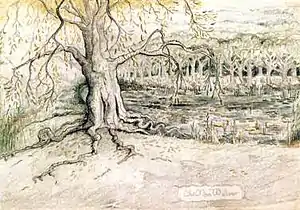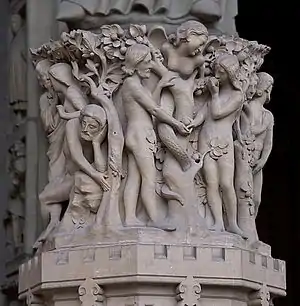Old Man Willow
In J. R. R. Tolkien's fantasy The Lord of the Rings, Old Man Willow is a malign tree-spirit of great age in Tom Bombadil's Old Forest, appearing physically as a large willow tree beside the River Withywindle, but spreading his influence throughout the forest. He is the first hostile character encountered by the Hobbits after they leave the Shire.

The character was omitted by both Ralph Bakshi and Peter Jackson from their film versions of The Lord of the Rings.
Context

The protagonist Frodo Baggins and his Hobbit companions Sam Gamgee and Pippin Took set out from his home at Hobbiton in the Shire. They are pursued by mysterious Black Riders.[T 1] They travel eastwards and cross the Bucklebury Ferry over the Brandywine River for the first time in their lives, meeting their friend Merry Brandybuck.[T 2] They rest briefly in Buckland,[T 3] deciding to shake off the Black Riders by cutting through the Old Forest.[T 4]
Character
Old Man Willow is a malign tree-spirit of great age in Tom Bombadil's Old Forest, appearing physically as a large willow tree beside the River Withywindle, but spreading his influence throughout the forest. As Tolkien explains in the narrative of The Lord of the Rings:[T 4][2]
But none was more dangerous than the Great Willow: his heart was rotten, but his strength was green; and he was cunning, and a master of winds, and his song and thought ran through the woods on both sides of the river. His grey thirsty spirit drew power out of the earth and spread like fine root-threads in the ground, and invisible twig fingers in the air, till it had under its dominion nearly all the trees of the Forest from the Hedge to the Downs.[T 5]
Narrative
In the story, Old Man Willow cast a spell on the hobbits, causing them to feel sleepy. Merry and Pippin leaned against the trunk of the willow and fell asleep, while Frodo sat on a root to dangle his feet in the water, before he also fell asleep. The willow then trapped Merry and Pippin in the cracks of its trunk and tipped Frodo into the stream, but the latter was saved by Sam, who, suspicious of the tree, managed to remain awake. After Frodo and Sam started a fire out of dry leaves, grass, and bits of bark in an attempt to frighten the tree, Merry shouted from the inside to put the fire out because the tree said it was going to squeeze them to death. They were saved by the arrival of Tom Bombadil who 'sang' to the ancient tree to release Merry and Pippin. The tree then ejected the two hobbits.[T 4]
Once safely in Tom Bombadil's house, Bombadil explained to the hobbits that the "Great Willow" was wholly evil, and had gradually spread his domination across the Old Forest until almost all the trees from the Hedge to the Barrow-downs was under his control.[T 5]
Drawing
Tolkien made a careful pencil and coloured pencil drawing of Old Man Willow while he was writing the chapter "The Old Forest"; Wayne Hammond and Christina Scull call it "a fine example" of the drawings he made to support his creative writing. They note that "with a little imagination"[1] a face can just be made out on the right-hand side of the tree above the arm-like branch. Tolkien describes it as a "huge willow-tree, old and hoary"; to the hobbits it seemed enormous, though Hammond and Scull observe that it does not seem so in the drawing. Tolkien's son John suggests that it was based on one of the few unpollarded willows on the River Cherwell at Oxford.[1]
Interpretations

Saguaro and Thacker comment that critics have puzzled over Tolkien's description of Old Man Willow, as it does not fit with Tolkien's image as an environmentalist "tree-hugger". They write that trees (like other creatures) are in Tolkien's world subject to the corruption of the Fall of Man, mentioning Tolkien's Catholicism. They state that while Tolkien's writings on the meaning of trees verges on the pagan, both the Old and the New Testament use trees as symbols, the Tree of Knowledge of Good and Evil in Genesis, the Cross, the tree of death in the Gospels, and the Tree of Life in Revelation (22:2); and that Tolkien succeeds in "bring[ing] all these elements together" in The Lord of the Rings: death, creation, sub-creation, re-creation.[2] Dickerson writes that Old Man Willow indicates both that nature, like Man, is fallen, and that it is actively hostile to Man.[3] The Tolkien critic Jared Lobdell compares the "treachery of natural things in an animate world" seen in the character of Old Man Willow to Algernon Blackwood's story "The Willows".[4] [5]
Paul H. Kocher writes that it is unclear whether the tree's malice derives from the Dark Lord Sauron, or is simply the tree's own "natural hatred for destructive mankind", and notes that the hostility extends to all travellers, "innocent and guilty alike".[6]
E. L. Risden states that the elimination of the Ring and Sauron along with his servants the Ringwraiths and Saruman removed the most powerful sources of evil in the world. Others like Old Man Willow were not removed, "but they too will now fade into quietness. The remaining world, blander, has more narrowly circumscribed limits."[7]
Adaptations
Old Man Willow, along with the Old Forest and Tom Bombadil, was not included in Peter Jackson's films of The Lord of the Rings. Justifying the excision, Jackson asked rhetorically in From Book to Script "So, you know, what does Old Man Willow contribute to the story of Frodo carrying the Ring? ... it's not really advancing our story & it's not really telling us things that we need to know."[8] Of the earlier adaptations, Terence Tiller's 1955–6 radio play did include Old Man Willow and Bombadil, though no recording survives. Morton Zimmerman's unproduced 1957 highly-compressed script, criticised by Tolkien for rushing rather than cutting, similarly included them: Bombadil takes the hobbits straight from Old Man Willow to the Barrow-downs, all the action in the episode seemingly occurring in one day. John Boorman's unproduced c. 1970 script did not include them; the hobbits "getting high on mushrooms" instead. Ralph Bakshi's 1978 animated film omits the Old Forest altogether, setting a precedent for Jackson. Although the hobbits do not pass through the Old Forest in Jackson's film of The Fellowship of the Ring, the map shown on screen earlier in the film does include Buckland, the Old Forest, and the Barrow-downs; however, in the extended edition DVD of The Two Towers, the Ent Treebeard speaks a version of Bombadil's unlocking words to Old Man Willow in Fangorn Forest, so, argues John D. Rateliff, there can have been no Old Man Willow in the mapped Old Forest, and no Bombadil, as the action takes place elsewhere.[8][lower-alpha 1]
Notes
- The scene is on The Two Towers extended edition, disk 1, from 1 hr 10.15 to 11.04, lasting some 50 seconds.[8]
References
Primary
- This list identifies each item's location in Tolkien's writings.
- The Fellowship of the Ring, book 1, ch. 3, "Three is Company"
- The Fellowship of the Ring, book 1, ch. 4, "A Short Cut to Mushrooms"
- The Fellowship of the Ring, book 1, ch. 5, "A Conspiracy Unmasked"
- The Fellowship of the Ring, book 1, ch. 6, "The Old Forest"
- The Fellowship of the Ring, book 1, ch. 7 "In the House of Tom Bombadil"
Secondary
- Hammond, Wayne; Scull, Christina (1995). J.R.R. Tolkien : artist & illustrator. London: HarperCollins. pp. 155–156. ISBN 978-0-261-10360-3. OCLC 34533659.
- Saguaro, Shelley; Thacker, Deborah Cogan (2013). Chapter 9. Tolkien and Trees J. R. R. Tolkien The Hobbit and the Lord of the Rings. Palgrave Macmillan (New Casebooks). pp. 138–154. ISBN 978-1-137-26399-5.
- Dickerson, Matthew (2013) [2007]. Drout, Michael D. C. (ed.). Trees. J.R.R. Tolkien Encyclopedia. Taylor & Francis. pp. 678–679. ISBN 978-0-415-96942-0.
- Nelson, Dale (2013) [2007]. "Literary Influences: Nineteenth and Twentieth Centuries". In Drout, Michael D. C. (ed.). J.R.R. Tolkien Encyclopedia. Routledge. pp. 372–377. ISBN 978-0-415-86511-1.
- Lobdell, Jared (2004). The world of the rings : language, religion, and adventure in Tolkien. Open Court. p. 9. ISBN 978-0-8126-9569-4. OCLC 54767347.
- Kocher, Paul (1974) [1972]. Master of Middle-Earth: The Achievement of J.R.R. Tolkien. Penguin Books. p. 66. ISBN 0140038779.
- Risden, John D. (2011). "Tolkien's Resistance to Linearity: Narrating The Lord of the Rings in Fiction and Film". In Bogstad, Janice M.; Kaveny, Philip E. (eds.). Picturing Tolkien: Essays on Peter Jackson's The Lord of the Rings Film Trilogy. McFarland. pp. 70–83. ISBN 978-0-7864-8473-7.
- Rateliff, John D. (2011). "Two Kinds of Absence: Elision & Exclusion in Peter Jackson's The Lord of the Rings". In Bogstad, Janice M.; Kaveny, Philip E. (eds.). Picturing Tolkien: Essays on Peter Jackson's The Lord of the Rings Film Trilogy. McFarland. pp. 54–69. ISBN 978-0-7864-8473-7.
.jpg.webp)